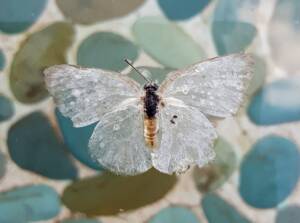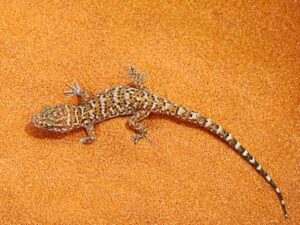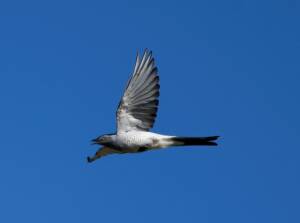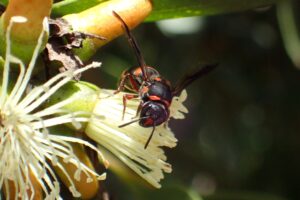StenotritidaeCtenocolletes albomarginatus Ctenocolletes rufescens Leioproctus (Protomorpha) sp Stenotritus bee
Images and Contributor Author Gary Taylor ◦
The males of this Leioproctus Protomorpha sp. are particularly fast and noisy fliers. The males occasionally alight to take nectar but most of their time from mid-morning to late afternoon is spent in flight.
The Leioproctus Protomorpha sp. taken on the Eucalyptus platypus, known as the Coastal Moort, were taken in mid January.
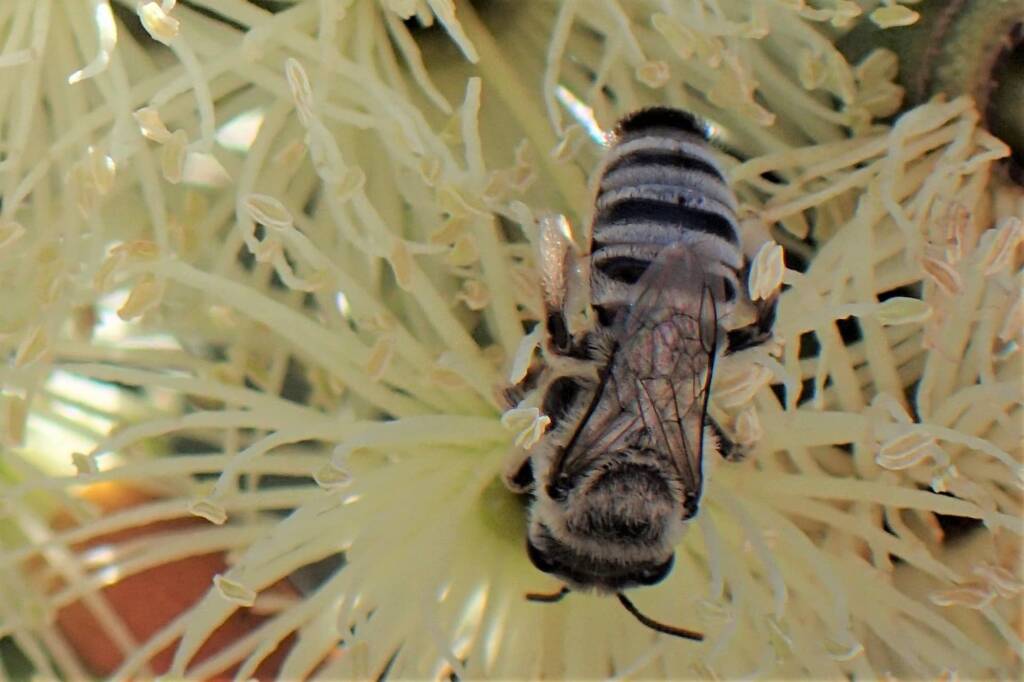
Aaaaaarrrggghhh! Idiot! Idiot! Idiot! goes the silent scream in my head…
When I first saw this big beautiful one come walking over the flowers the mind said “by the size and length of it, it’s some kind of flower wasp…” never seen a grey one before… But the gut was saying “No, there’s something different about this one…” so I snapped a couple of half hearted pics…
When I loaded the pics on to the computer where I could see clearly, I saw the tuft of fur on the butt. That’s pre-pygidial fimbriae, a specialised adaptation found in ground nesting bees that is used to brush secretions produced by the abdomen on to the inner walls of her burrow, a bit like brushing Bondcrete on to fretting mortar to stop it falling apart…
Aaaarrrggghh… a brand new bee for the albums and I only took three pics… Stupid mind, I’m never listening to it again! 😆
Author Gary Taylor, Geraldton, Midwest WA

The difficulty of identifying is illustrated here, with the first ID of this native bee, being that of the male Ctenocolletes nicholsoni, which has now been revised to Leioproctus Protomorpha sp.
Bee probably went through difficult times, flagellar segments broken, both sides… Stenotritidae, u are right. Metasomal segments elongated, extremity presence two tiny spines. It is a male. Apical margins of metasomal terga pale towards end, last tergite brown-black. Might be: Ctenocolletes nicholsoni (Ckl.).
Additional ID information – Roch Desmier de Chenon, Bee Aware of Your Native Bees (Australia)

- Scientific classification
- Kingdom: Animalia
- Phylum: Arthropoda
- Subphylum: Hexapoda
- Class: Insecta
- Informal: Pterygotes
- Order: Hymenoptera
- Superfamily: Apoidea
- Informal: Apiformes
- Family: Colletidae
- Subfamily: Neopasiphaeinae
- Genus: Leioproctus
- Subgenus: Leioproctus (Protomorpha) Rayment, 1959
Footnote & References
- Ctenocolletes nicholsoni, Photographs and content contribution by Gary Taylor, Western Australia
- Additional ID information, Roch Desmier de Chenon, member of Bee Aware of Your Native Bees (Australia), https://www.facebook.com/groups/beeawareofyournativebees
- Biological Observations of Bees in the Genus Ctenocolletes, Terry F. Houston (PDF), Stenotritidae – Western Australian Museum, https://visit.museum.wa.gov.au/
- Stenotritid Burrowing Bee – Ctenocolletes nicholsoni, Lochman Transparencies, https://www.lochmantransparencies.com/products/australian-wildlife/stenotritid-burrowing-bee-ctenocolletes-nicholsoni/
BeesBees Anatomy Bee Behaviour Blogging Bees… Bees – image index Bees – Index Lists Unidentified Australian Native Bees Amegilla Bees Apis mellifera Austroplebeia australis Austrothurgus Braunsapis sp Ceylalictus perditellus Colletidae Euryglossinae Exoneura Hyleoides bivulnerata Lasioglossum Lasioglossum (Chilalictus) Lasioglossum (Homalictus) Leioproctus pappus Lipotriches Megachile Meroglossa Resin Bees and Resin Pot Bees Stenotritidae Tetragonula Thyreus Xylocopa
StenotritidaeCtenocolletes albomarginatus Ctenocolletes rufescens Leioproctus (Protomorpha) sp Stenotritus bee



